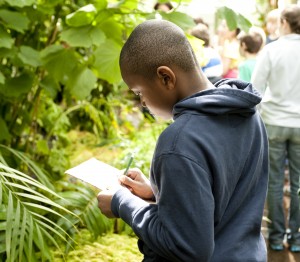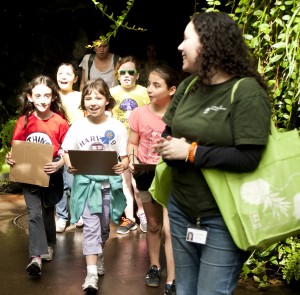GreenSchool in the Rain Forest: A Third Grade Excursion
Posted in Learning Experiences on May 16 2012, by Tai Montanarella
Tai Montanarella is the Manager of School and Family Programs at The New York Botanical Garden.
 How do plants in the rain forest survive? This was the question on the minds of Prospect Hill Elementary School students as they explored the Enid A. Haupt Conservatory. It was here at the NYBG that they became first-hand field scientists for a day, embarking on their own botanical expedition through the diverse tropical rooms of our glasshouse.
How do plants in the rain forest survive? This was the question on the minds of Prospect Hill Elementary School students as they explored the Enid A. Haupt Conservatory. It was here at the NYBG that they became first-hand field scientists for a day, embarking on their own botanical expedition through the diverse tropical rooms of our glasshouse.
While they did not have to get on a plane to visit these rain forests, these third graders did have to travel through extreme biomes before they could reach them. This is a museum of plants, after all. Their journey began when they got off the bus, where they were not only greeted by GreenSchool educator Pilar Okeson, but by a fantastic Zelkova tree (Zelkova serrata). Hailing all the way from Japan, this deciduous tree does equally well in the temperate climate of New York City, and can reach 100 feet tall. It was only the first of many exotic plants the children would encounter.
Shortly after, they approached the classic Victorian glasshouse and–looking from the outside in–the Prospect Hill students suspected that their landscape was about to change. They could see a world of green through the Conservatory glass, but how were those plants different from the ones they see each day in their own neighborhoods, and why were they protected inside this extraordinary building?
They entered through the glass door and into an African desert of ancient plants, where euphorbia and succulents abound; soon after, the students found themselves among tall cacti representing the deserts of the Americas. This was not a rain forest by any means, though their fascination grew with each strange plant introduced. Passing through the mouth of a long, dark tunnel beneath the desert collections, they were prepared to enter their chosen field of study. But a botanical expedition is only as good as the careful record a scientist keeps, making a field journal a botanist’s number one necessity. Pilar distributed clipboards with paper and pencils for students to make sketches and write down their findings.
[Not a valid template]The idea that tropical forests could only be hot and humid places was quickly dispelled as the students immersed themselves in the Upland Rain Forest house, similar to rain forests found in the high mountains of Latin America. There they discovered that rain forests could be cool–even cold–as they learned that these high-altitude biomes (above 3,000 feet!) are actually referred to as cloud forests; rather than constant rainfall, the cooler temperatures and wind bring heavy mists.
Still pondering the question of how these rain forest plants survive, the students began their observations, drawing and collecting information about the plants around them–mosses, ferns, and bromeliads, each with a special shape and method of gathering nutrients. Pencils scribbled down information as they answered questions about epiphytes, or plants that capture their nourishment from the moisture in the air.
The next destination was the tropical Lowland Rain Forest. With its storied skywalk, each third grader climbed through the layers of a forest they had only read about in books, reaching the canopy and looking down to observe and collect information of what lay below–the broad leaves of understory plants, the lianas winding their way through the building, and the tangled buttress roots supporting a giant kapok tree. This hot and humid rain forest with its climbing vines, towering palms, and economy plants–like cinnamon and cocoa–provided the basis for serious conversations on the importance of these environments.
 However, the NYBG GreenSchool is more than a Conservatory tour. Hidden between the deserts and rain forests are classrooms where school groups often convene at the end of their expedition. Call it a field station if you will. In these classrooms, Prospect Hill kids had the chance to engage in even more hands-on learning and small-group discussions. They worked together, shared information, and compiled what they had discovered about plant adaptations, organizing all of their material on table top science journals. To culminate their day of learning, each student got to pot up a Coleus “Wizard Mix” plant to take home for further observation, and maybe even some experimentation with leaf propagation.
However, the NYBG GreenSchool is more than a Conservatory tour. Hidden between the deserts and rain forests are classrooms where school groups often convene at the end of their expedition. Call it a field station if you will. In these classrooms, Prospect Hill kids had the chance to engage in even more hands-on learning and small-group discussions. They worked together, shared information, and compiled what they had discovered about plant adaptations, organizing all of their material on table top science journals. To culminate their day of learning, each student got to pot up a Coleus “Wizard Mix” plant to take home for further observation, and maybe even some experimentation with leaf propagation.
But after such an expedition, how do plants in the rain forest survive? Buttress roots, drip tips, thick, waxy cuticles, and fancy leaf arrangements are all good hints. Climbing through the layers of the rain forest for yourself might help you reach your own conclusion. Still, you could just ask a third grader from Prospect Hill Elementary School.

